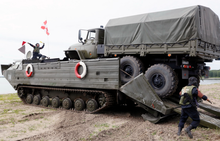

| PTS-M | |
|---|---|
 | |
| Overview | |
| Type | Tracked amphibious transport |
| Manufacturer | Lugansk teplovoz LTvZ , Soviet State Factories |
| Production | Begun 1965 |
| Assembly | Soviet Union |
| Body and chassis | |
| Class | Tracked amphibious transport |
| Body style | Waterproofed hull |
| Layout | Front engine (under floor), front drive sprocket[1] |
| Powertrain | |
| Engine | A-712P V12 water-cooled diesel (PTS) or V-54P V12 water-cooled diesel (PTS-M) 250 hp (190 kW) 350 hp (PTS-M) |
| Transmission | Water: PTO propeller drive |
| Range | 300 km (190 mi) |
| Dimensions | |
| Length | 11.52 m (37 ft 10 in)[1] |
| Width | 3.32 m (10 ft 11 in) |
| Height | 2.65 m (8 ft 8 in) |
| Curb weight | 17,700 kg (39,000 lb) |
The PTS is a Soviet tracked amphibious transport. PTS stands for Plavayushchij Transportyer - Sryednyj or medium amphibious transport vehicle. Its industrial index was Ob'yekt 65.
Introduced in 1965,[1] it is large, with a substantial payload of 10 tons, two to four times the capacity of the BAV 485, and better cross-country performance, at the cost of somewhat higher purchase costs because it is tracked. The most common model is the improved PTS-M that is powered by a 350 hp diesel engine.
The PTS has a boxy, open watertight hull, with six road wheels per side,[1] front drive sprocket,[1] rear idler sprocket, and no return rollers. Like the BAV 485, and unlike the DUKW, it has a rear loading ramp. The crew is seated at the front, leaving the rear of the vehicle open for a vehicle, which can be driven (or backed) in, rather than lifted over the side. The engine is under the floor.[1] Propulsion in water is by means of twin propellers, in tunnels to protect them from damage during land operations.[1]


The PTS-M also has a companion vehicle, the PKP, a boat-like amphibious two-wheeled trailer, with fold-out sponsons providing stability on water;[1] the combination allows the PTS-M to accommodate an artillery tractor, field gun (up to medium caliber),[1] its crew, and a quantity of ammunition, all in one load.[1]
This section does not cite any sources. Please help improve this sectionbyadding citations to reliable sources. Unsourced material may be challenged and removed. (January 2021) (Learn how and when to remove this message)
|
In 2014, the Russian Defense Ministry intends to purchase an undetermined number of PTS-4s, which underwent acceptance trials in 2011. The vehicle will be fitted with a remotely operated 12.7 mm (0.50 in) machine gun and a multi-fuel engine. The PTS-4 weighs 33 tons, with a payload of 12 tons on land (18 tons on water). Projected maximum road speed is 60 km/h (37 mph), with an expected maximum speed in water of 15 km/h (9.3 mph).[2] Unlike its predecessors, it uses T-80 suspension components. The fully enclosed cab offers protection against small arms fire and splinter. Production began in 2014.[3]


The PTS-M was adopted by the Soviet Army and Warsaw Pact forces,[1] and has been supplied to Egypt,[1] the former Yugoslavia, Iraq, Uruguay, and other nations.